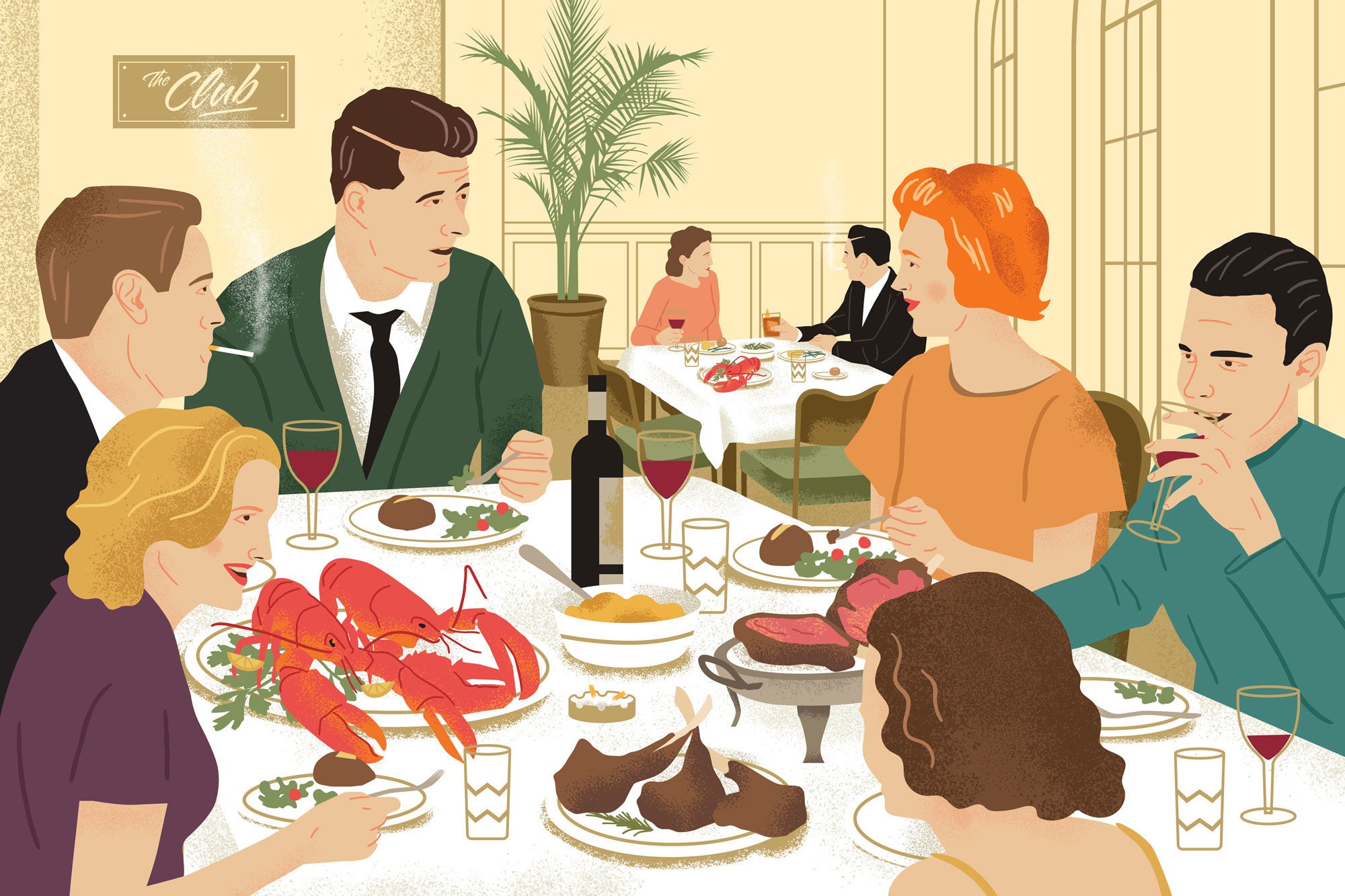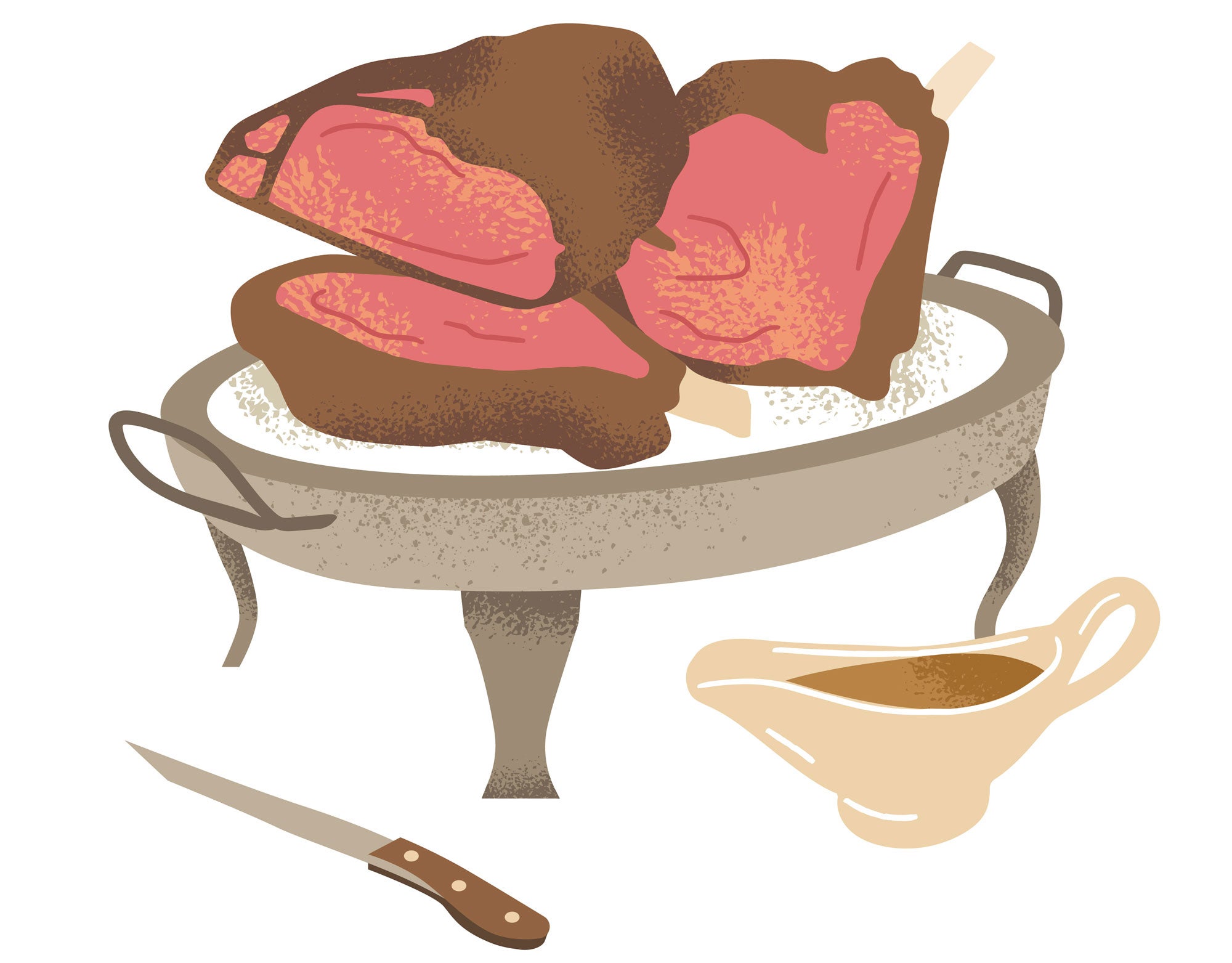
There’s a sudden urge to dine in a time before tofu and Title IX. Why now?
There’s a particular vibe quickly established when you walk into TAK Room, Thomas Keller’s latest project at New York’s Hudson Yards complex. Bartenders glide about in high-collar jackets, finishing off a Sazerac with a spritz of absinthe from a cut-crystal spray bottle that might have come from the perfume counter at Neiman Marcus across the hall. On a recent night, a jazz ensemble murmured through “A Night in Tunisia.” Add a menu of tableside Caesar, a sculptural Louie-style salad of avocado and fresh vegetables, and an $85 lobster Thermidor, and it amounts to a fantasia of old country-club dining. The question is, why now?
It helps to know that TAK Room is a remake, the third variation on a theme. In 2015, during renovations at The French Laundry, Keller launched Ad Lib, a pop-up at Napa’s Silverado Resort & Spa. Here, America’s most celebrated chef could revisit the (sort of) ritzy dining he began his career with: steak, shrimp cocktail, and Caesar salad prepared tableside, sometimes by Keller himself. Clearly Keller liked the idea. He repeated it at The Surf Club, near Miami, the house restaurant for a hotel and private club—a revival of what once was one of Miami’s toniest spots. TAK Room’s menu is effectively a mimeograph from Miami: not just lobster Thermidor, but a beef short rib Wellington, that fusty lord of meat dishes, which at more than $130 reigns second only to a $160 New York strip.
This sort of food, Keller explained in an interview with CNBC’s “Power Lunch” (of course it was “Power Lunch”), was a tribute to his childhood, namely to the restaurants his mother Betty ran in Florida, which specialized in what Keller described as “Continental cuisine.” For a certain type of patron, one who thinks veal is the other white meat, that creamed spinach is health food, and prefers their wine lists with Kistler chardonnay over pét-nat and chenin blanc, here was a safe space, with a menu that’s utterly comfortable—to borrow the word Keller repeated during his interview.
“There’s nothing on it I don’t understand,” CNBC’s Tyler Mathisen said.
“That’s good,” the chef replied.
The cheap shot, of course, is that TAK Room is a restaurant tailor-made for the one-percent oasis that is Hudson Yards. And certainly, the Yards’ key developers, Ken Himmel and Stephen Ross, are big fans and supporters of Keller. But things aren’t so black and white. Among the neighboring restaurants in the mall are David Chang’s Kāwi, perhaps his most boldly Korean spot in an empire of more than a dozen restaurants around the globe, and one of his best of late (Keller, in a cringey bobbling of words, referred to it as “David Chang doing his Asian downstairs”), and Mercado Little Spain from José Andres, that master of threading a democratic needle between privilege and inclusion. No, something else is afoot.
A couple of years ago the restaurant critic Bill Addison defined the “New Romanticism,” essentially an American evolution of the New Nordic. It consisted of dishes that were subtle without being overly intellectual: geometrical on the plate, but still satisfying, marked by edible flowers and other accouterments of foraging and fermentation—“a reaction,” Addison put it, “to the meat-dazed, burger-as-dare, put-some-foie-on-it hyper-masculine trends that bulldozed through the last decade.” While this might have included restaurants like Brooklyn Fare or Eleven Madison Park, a key aspect was that such cooking no longer required virtuosic fine dining. It was more about the ways that Jeremiah Stone and Fabián Von Hauske quietly luxuriated at their wine bar Wildair, or how Ryan Smith invoked both chicken livers and koji at Atlanta’s Staplehouse. It was about navigating a tricky path between delicacy and gratification.
As such, the New Romanticism represented a blue-, or at least purple-state, gastronomy. So clearly there would be a snapback—not just away from the tasting-menu theatrics of, say, EMP, but from the entire prospect of more thoughtful cooking. And that retrenchment manifested itself in both subtle and unsubtle ways. For example, in 2018 the Houston chef Chris Shepherd transformed his original groundbreaking restaurant, Underbelly, into a steakhouse, Georgia James. There, he offered a dish he’d first debuted about a year earlier: the “baller board,” a Noah’s Ark worth of creatures piled onto a plank—various forms of beef, lamb, poultry, offal, lobster, and so on. It was a YouTube challenge in entrée form, for those for whom cost and cholesterol were no object. It became a cult hit in Houston. In Chicago, the team behind Alinea has opened St. Clair Supper Club, a nod to Wisconsin dining clubs, specializing in prime rib. And in San Francisco, a FiDi spot called the Vault has built much of its menu around Parker House rolls.
I have to believe that Shepherd, whose Underbelly exalted diverse culinary traditions, must be in on the baller-board joke. And I’m pretty sure Angie Mar saw how fronting an intensely beefy menu at New York’s Beatrice Inn would tweak the macho culture of the clubby New York steakhouse. But is there a knowing wink as TAK Room serves up rounds of the Pendennis Club cocktail? I’m less sure.
The writer Brett Martin suggested a term for this countertrend: the “New Nostalgia.” And some of this may legitimately be that. But to me, nostalgia is kinder and gentler than a more aggressive vein that I detect in at least some of these examples. So instead let’s call it the “Great Regression.” Because the TAK Room isn’t just offering an alternative to the New Romanticism; it’s repudiating its thoughtfulness. Keep your Noma sensibilities and edible flowers, stick them into the part of a cow not served on a silver trolley, and let us dine in a time before tofu and Title IX.
Certainly, Keller isn’t alone in this. On the nostalgia front, Martin specifically was referring to The Grill, opened by the team at Major Food Group in the old Four Seasons space on Park Avenue, plus its sibling, The Pool. Partners Rich Torrisi, Mario Carbone, and Jeff Zalaznick wanted to pay tribute both to the ballerness—the power dynamics at play—of the Four Seasons, and to the crisp presentation of Continental cuisine. The Grill unselfconsciously calls itself a “chophouse,” and retro is as retro does: lamb chops with mint jelly, a cold buffet (that’s not actually a buffet, because for those prices you’re not plating your own food), shining trolleys of prime rib.
This is less nostalgia than simply hearkening back to a tonier iteration of Saturday dinner at the country club. And that sort of reaching backward worries me, because the past few years have made clear the perilous line between the glow of nostalgia and the myopia of Making America Great Again. But more saliently, the restaurant industry has endured a reckoning in the past two years, forced to confront the Mario Batalis and Ken Friedmans of the world—revealed as serial harassers and ejected, somewhat forcibly, from their restaurant empires. It has finally started wrestling with its deep issues of inequality: a look at any recent lineup of top restaurants and chefs will show a sudden influx of women and chefs of color into the culinary conversation. In other words, if you feel the desire to play with nostalgia, you’d better be careful about how you use it.
Of course, there’s nothing inherently wrong with this food. Why turn down a proper rendition of lamb chops with mint jelly, or refuse the pleasure of a good chopped salad, to say nothing of crêpes Suzette flambéed at your elbow? (Such things were the last pleasures of the old Four Seasons in its threadbare days.) But I find it hard to accept that “Continental cuisine” needs to be revived. For one thing, even in its 1960s heyday, it was a slippery bit of jargon: vaguely French, but more an ethnically fuzzy American catchall for any vaguely Western European cuisine.
This is less nostalgia than simply hearkening back to a tonier iteration of Saturday dinner at the country club.
It was, for instance, already controversial when the original Four Seasons opened in 1959. Here was the country’s most expensive restaurant to date, costing $4.5 million ($39.5 million in today’s dollars) for the Philip Johnson interior and Mark Rothko murals—all clear symbols of American exceptionalism. The food in the kitchen—horreur!—was not classically French. Swiss chef Albert Stockli was “largely unfettered by European tradition,” Craig Claiborne wrote in the Times, with slight disapproval. Claiborne wished for more French refinement, and lambasted the large portions, “a barbaric custom that is all too common in American dining places.”
But Americans made increasingly clear that they preferred this over the French formalism of the past. The great expat chefs who had arrived during the 1930s bemoaned a coming end of an era. “No more sauce champagne, no more sauce Robert, no more filet of beef Wellington,” Humbert Gatti, chef of the Plaza Hotel, told Claiborne. Actual French food would be increasingly democratized, particularly after Julia Child first appeared on TV in 1963. And in its place we’d get Continental cuisine—a safer spin on authentic European cooking. Something more comfortable.
Soon it became code for snoozy but fancy-seeming food—country-club food. By the time Keller would have encountered it at, say, his first cooking job in 1974 at the Palm Beach Yacht Club, it had devolved into a totem of complacency for the typical American palate, which was why Claiborne, in the early 1980s, derided it as nothing more than “great undecisiveness [sic] and unknowingness on the part of the restaurant owners.” It was the equivalent of the “Asian flavors” idiom used in the West.
Certainly the food at TAK Room largely achieves Kellerian standards, in that its seeming approachability hides meticulous technique. And it’s undoubtedly intended to continue the Continental tradition—although this food even in its best guise is hard to define as Continental in a literal way, unless the continent being celebrated is this one. Consider the origins of dishes like oysters Rockefeller (New Orleans), Louie salad (San Francisco), celery Victor (San Francisco again, from the same chef—Victor Hirtzler), even that beef Wellington (the Brits credit us with that). Today, they can often be found in far more democratic settings, whether San Francisco’s Swan Oyster Depot or Pascal’s Manale in New Orleans, which makes it even more awkward to have them appropriated as symbols of moneyed “Continental” refinement.
In the end, what food and settings like this are truly about is making a space for the powerful. And the most cosseted of power spaces was the Four Seasons. Ironically, by the time Keller was cooking in Palm Beach, the original Four Seasons was in decline, as were other New York temples of Continental cuisine, like Quo Vadis. The era that some of today’s restaurants hope to emulate really began in the mid-1970s, after the Four Seasons was purchased by Tom Margittai and Paul Kovi, who hired a Tuscan hotelier, Julian Niccolini, to preside over the dining room. They recrafted the Four Seasons as a legendary nexus of privilege, with its own social hierarchy.
That hardly seems like the sort of thing that needs to come back in 2019, given the baggage that comes along. Even Seagram Building co-owner Aby Rosen figured that bit out, sort of. He was explicit that he wanted the new Grill to be “fun,” rather than a power spot, even as he acknowledged that actual fun people might not be able to fork over $250 for dinner. In which case, why are these places here? The only way to justify the ludicrousness of an $85 sole meunière is to conclude that these prices are not a bug but a feature—the new conspicuous consumption, marked by its attempt at inconspicuousness. And that part of the Great Regression, at least, is welcome to go away, because the past couple of years should have taught us that restaurants can reasonably be judged today not only on their food, but their values.
The prime example, actually, is the brief, dismal trajectory of the newly revived Four Seasons, which moved a few blocks away, indulged in a $40 million buildout—as expensive in today’s dollars as the 1959 original—and shuttered in less than a year. It wasn’t helped by Niccolini’s reputation for harassing women, but things didn’t improve even after he was forced out. Perhaps something simpler was at work, though. Most of the world has moved on from needing that sort of safe space for the rich and entitled. There’s plenty of comfort to be found in corners that don’t also evoke a time, not too long ago, when a lot of people were told they didn’t belong.


